More workplaces opening their doors to girls in maths and science
This generation of VCE students no longer think about “jobs for girls” and “jobs for boys”, as more doors open for girls to follow their nose towards science and maths subjects.

Lifestyle
Don't miss out on the headlines from Lifestyle. Followed categories will be added to My News.
They’re as comfortable talking about “classical and medicinal bionics neuromodulation therapies” and “optogenetics” as they are about selfies and Instagram.
Tara Stewardson and Emma Nguyen are of a generation whose mothers may well have been told there were “jobs for girls” and “jobs for boys”.
But these 16-year-olds are among a growing number of female VCE students following their noses towards STEM (science, technology, engineering and mathematics) subjects.
But the glass ceiling hasn’t been completely smashed by Gen Z. Some subjects remain a boys’ club. And the challenge remains to keep women in the industry.
While girls account for just over half of the enrolments in year 12 science subjects, double the number of boys are studying advanced maths in their final year. Boys outnumber girls three to one in physics.
Just a third of university graduates in maths, physics and astronomy are women. They make up less than 15 per cent of those with engineering degrees, and are less likely to study IT.
As part of its 10-year vision to increase participation in the industry, the Federal Government’s Advancing Women in STEM plan — launched in April — acknowledges the causes of the disparities are “broad, complex and longstanding”.
Some include stereotyping and a lack of perceived ability. The government report also recognises there is a lack of diverse female role models, as well as a perception some jobs are
a better fit for males.
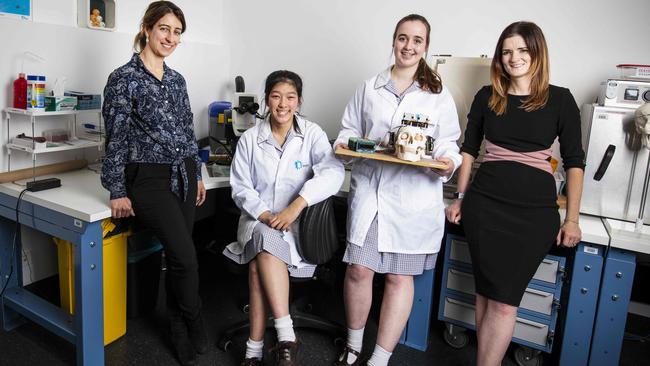
But an increasing number of Victorian medical research institutes and hospitals are establishing partnerships to overturn these barriers and net young female talent early.
Each year, the Royal Women’s Hospital hosts about 150 female high school students
for the day, where they hear from doctors and scientists, and take part in hands-on activities such as mock newborn resuscitation and diagnosing endometriosis via pathology slides.
The Walter and Eliza Hall Institute of Medical Research established the Gene Technology Access Centre, next door to Parkville’s University High School, to give students the chance to work on real research projects in the laboratory.
Peter MacCallum Cancer Centre amasses a waiting list of budding researchers for its work-experience program, while the Florey Institute of Neuroscience and Mental Health sends its scientists out on the road to high schools.
The Bionics Institute has teamed with Ivanhoe Girls’ Grammar School for the first time this year to pair students with high-performing young researchers on a project.
The institute is founded on the development of the cochlear implant, with much of its research now based on tweaking this electrode technology and applying it to other conditions such as hearing loss, stroke, epilepsy and Parkinson’s disease.
The partnership saw female researchers pitch their projects to the students, who then selected an area they wanted to work on.
Stewardson chose to work with research fellow Dr Sophie Payne, who is part of a team that developed an implantable device to stimulate the vagus nerve running from the brain to the gut as a potential new treatment for inflammatory bowel disease (IBD).
This work has received financial support from the US military’s research arm, and will be surgically implanted in the first human patients before the end of the year.
The year 11 student’s task has been to comb published medical research for evidence of the success of different therapies for IBD to help guide Payne’s work.
“I really love how you can use science to solve everyday problems, which can help change the world,” Stewardson says.
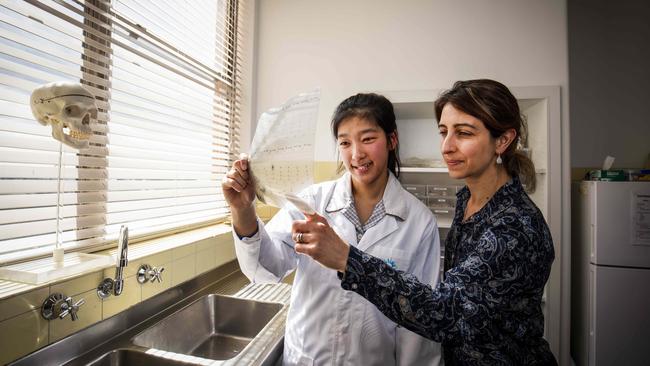
Her classmate Nguyen has teamed up with Associate Professor Rachael Richardson, who is working on using the power of light to control the activity of cells — a new field called optogenetics — as a way of making the cochlear implant perform even better.
Ivanhoe Girls’ Grammar principal Dr Deborah Priest, who first trained as a mathematician, says the partnership was one of a number of ways they were helping their students connect their classroom learning with the real world.
Other projects include year 9 students collecting possum poo in a collaboration with Macquarie University to investigate antibiotic resistance in the food chain by using the school’s new DNA-analysing machine.
“So many jobs of the future are going to have elements of science or technology or mathematics in them, so I’m passionate about making their learning more relevant and engaging,” Priest says.
Payne’s light-bulb moment came when she was around the same age as Stewardson.
She heard Oxford University Professor Baroness Susan Greenfield speak about the wonders of the brain and was hooked.
“Seeing is believing,” Payne says.
“She was really alone in that field and a pioneer for young girls like me to start coming through the pipeline.
“That gave me the confidence in high school to go yes, I will do neuroscience.”
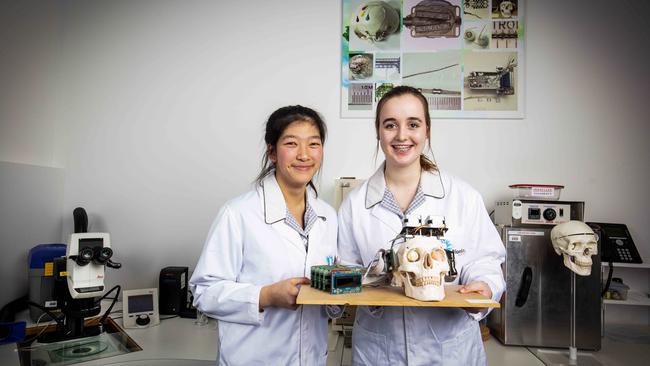
Payne credits the Bionics Institute’s flexible work arrangements and networking opportunities for attracting high-quality female researchers. But in the bio-engineering and medical device industry she works in, the 33-year-old is still in the minority.
During a recent experiment that involved a group of 10, nine were male.
“That’s why I’m passionate about providing support to younger students, so they know there are women out there who are approachable and that it’s a very rewarding industry,” Payne said.
Health Minister Jenny Mikakos said the State Government would continue to play its part in helping encourage a passion in STEM, so students were “at the forefront of emerging technology and prepared for the jobs of the future”.
“Melbourne is Australia’s tech city and Victoria is a growing tech hub across the Asia-Pacific region and that is why we need to lead by example when it comes to increasing the vital contributions that women make to STEM,” Ms Mikakos said.
“We’re working towards sustained increases in women’s participation and retention throughout early childhood, education and careers. This includes not only celebrating and highlighting the incredible achievements of women in early career research but also encouraging and backing more women in these fields.”
Meanwhile, other researchers across Melbourne are working on keeping female researchers in the industry.
Dr Joanna Groom, co-chair of the Walter and Eliza Hall Institute of Medical Research’s gender equity committee, says it was this time of career establishment — around the late 20s and early 30s — where women needed practical support.
The typical next step after a PhD is postdoctoral research, where young scientists start to develop their own research priorities and ideas, before going on to apply for a position of laboratory head.
“This is a time we’re supposed to be all cylinders firing, but it’s also the time when we’re thinking about starting families,” Groom says.
The WEHI is a leader in the industry on this front, having opened the first childcare and early-learning centre at a medical research institute. They are mindful of flexible work conditions, so there is a blanket rule across the institute that meetings don’t start before 9.30am or finish after 4.30pm.
“Tackling issues with career disruption are a bit easier because they’re upfront and obvious,” Groom says. “What I think is harder, and what I’m proud the institute is starting to address, are those other barriers women face throughout their careers.”
This includes ensuring men and women are equally represented at all institute events, and that more mentorship and sponsorship opportunities are open to women.
“Historically, men have been over-represented in the top jobs,” she says. “We know there’s a tendency for people to mentor people who are like them. If those conversations are only being passed on to the up-and-coming men, then women are left out.”
For Groom, keeping educated, passionate and talented women in science is a no-brainer.
“It’s really a waste for the individual, the institute and the whole sector if we’re training these people and not providing them with the same opportunities, regardless of their gender or background.
“Studies have shown that when we have diverse teams, we work more effectively and are more innovative with problem solving. When we’re thinking about solving health problems, that is exactly the type of innovation we need.”
Advice for students interested in STEM – from the experts
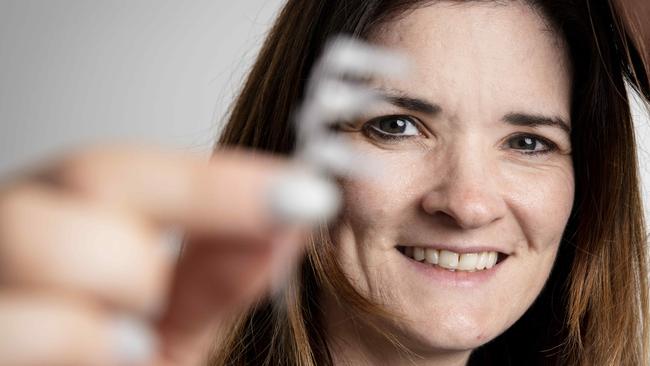
DR SOPHIE PAYNE
– Job title: Research Fellow, Bionics Institute
– Age: 33
– What did you study at uni? BSc (Hons), PhD (Neuroscience)
– What do you do? Providing experimental evidence to show that this IBD device is safe and it works in preclinical model. Now starting to target other diseases with this device; type 2 diabetes and rheumatoid arthritis.
– Why do you love your job? This industry is very rewarding. You can see results very quickly.
– What are your hobbies outside work? Running, boxing and rock climbing.
– What advice do you have for high school girls keen on getting into STEM?
Keep at it. If it’s something that you’re passionate about don’t let anything stand in your way. Make sure you find a mentor, someone you connect with. It helps your inspiration, but it can also help you navigate through these hurdles that will exist on your path.
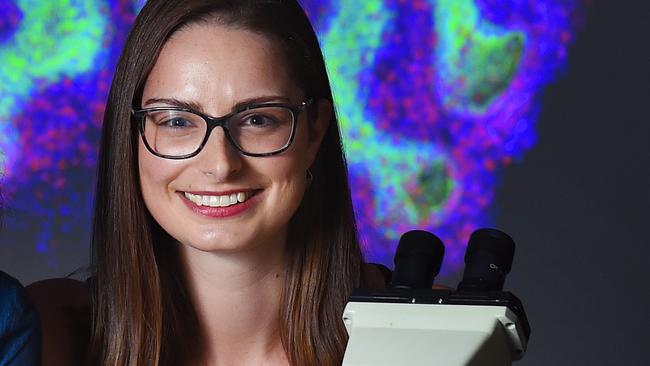
DR SARAH BEST
– Job title: Senior postdoctoral scientists, Walter and Eliza Hall Institute of Medical Research
– Age: 31
– What did you study at uni? BSc (Hons), PhD (Medical research)
– What do you do? I am an epithelial tumour biologist, which means I investigate why and how cancers develop in solid organs and how to effectively treat these cancers. Currently, my research focuses on a particularly aggressive form of lung cancer and how we can personalise treatment for these patients.
– Why do you love your job? I work with a fantastic team of people who are all passionate, intelligent and hardworking. I love problem-solving, which in a nutshell is what my job is all about.
– What are your hobbies outside work? I enjoy spending time with friends and staying active
– What advice do you have for high school girls keen on getting into STEM?
You won’t know if STEM subjects are for you until you try them out. In high school, I wasn’t thinking about science at university until Year 10, when I watched the WEHI.TV movies and could visualise what was actually going on in a cell. That exposure hooked me in, and I loved learning more about biology. So, if you get the opportunity to get immersed in STEM, give it a go!
FOR INFO, VISIT WOMENINSCIENCEAUST.ORG, STEMWOMEN.ORG.AU OR FORWOMENINSCIENCE.COM.AU
